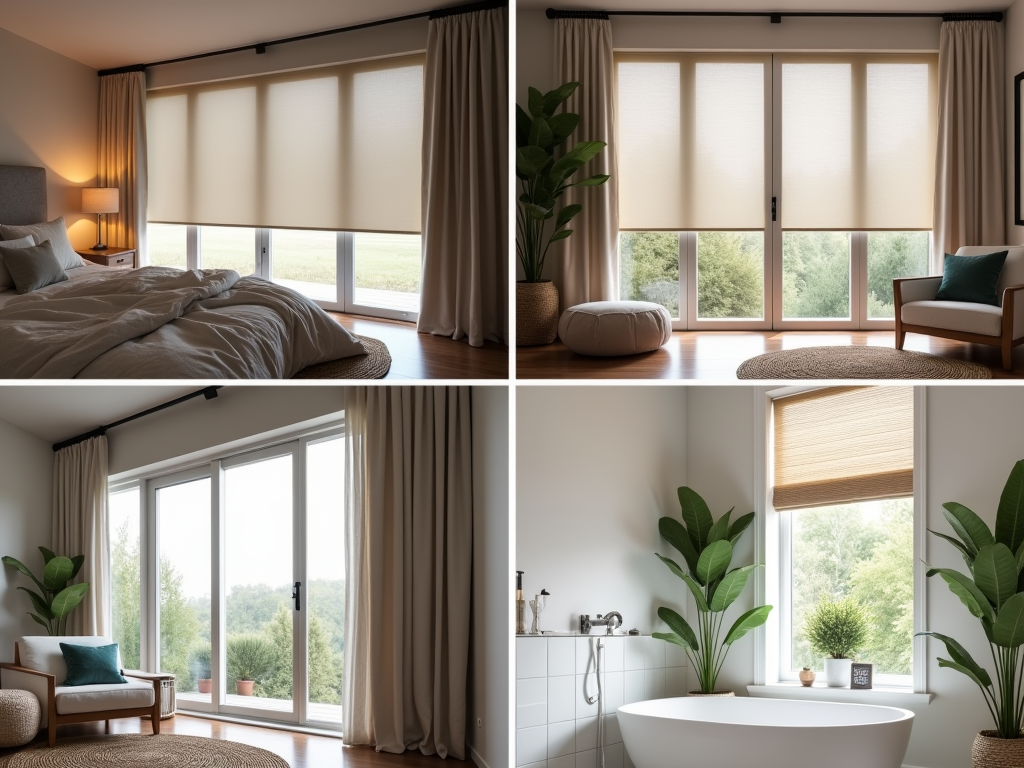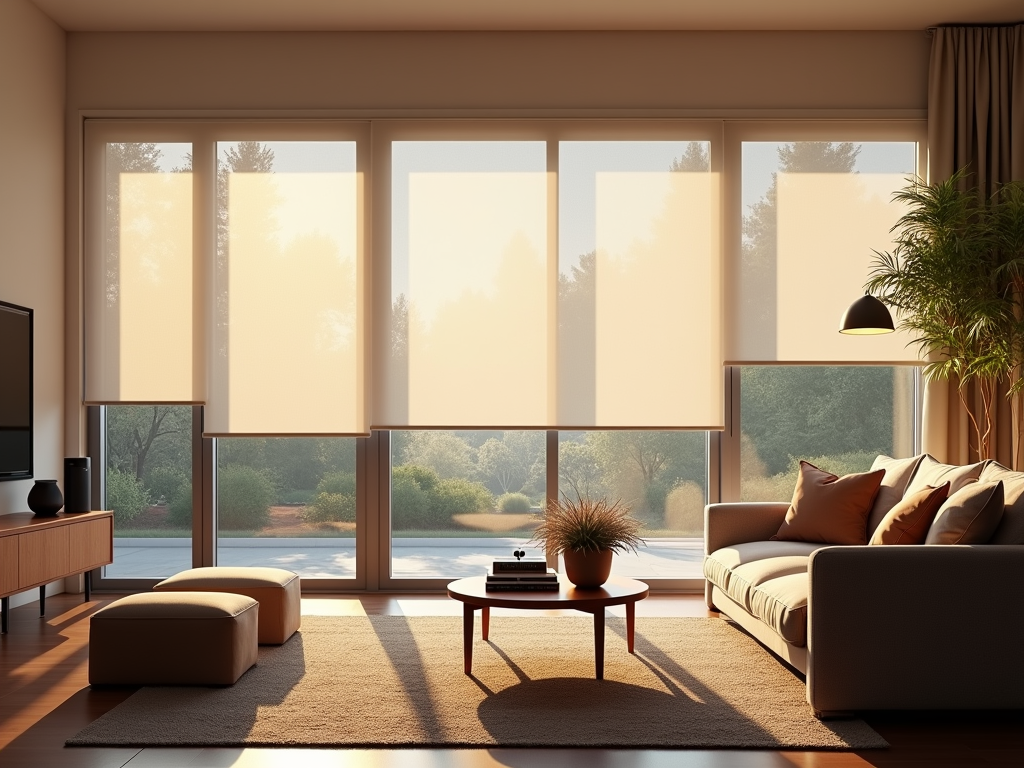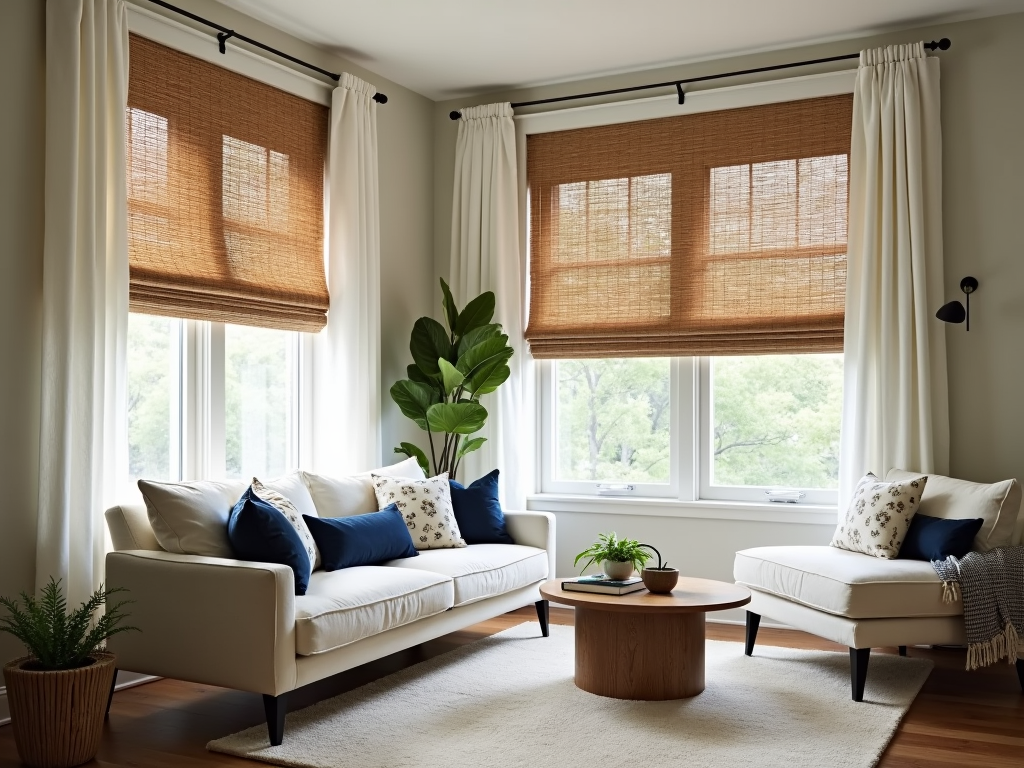
The right window coverings can transform a space, balancing style with practicality. They optimize light control, boost energy efficiency, and provide privacy. Options include sleek roller shades, elegant Roman styles, and versatile blinds such as Venetian or vertical designs. Selecting the best choice depends on the room’s needs, your design preferences, and budget constraints.
Key Takeaways
Window Shades
Roller shades deliver a clean, modern aesthetic. Cellular shades stand out for energy savings, while Roman shades bring timeless sophistication with their soft fabric folds.
Window Blinds
Venetian blinds allow for precise light adjustments. Vertical blinds are perfect for large windows or sliding doors, and mini blinds offer an affordable solution for smaller spaces.
Cost Considerations
Basic roller shades start around $20–$50 per window, but high-end options like custom Roman shades may cost over $300. Features like motorization can add $150–$300 to the price.
Smart Features
Motorized or smart window treatments connect with platforms like Alexa or Google Assistant, adding convenience, scheduling capabilities, and potential energy savings.
Room-Specific Recommendations
- Blackout shades work wonderfully for bedrooms.
- Vertical blinds handle sliding doors effectively.
- Moisture-resistant options are the best pick for bathrooms.
Transform Your Space with the Right Window Coverings
The right window coverings can completely shift the look and feel of a room while offering practical perks. There are so many options, but shades and blinds really stand out because of their versatility and functionality.
A Look at Popular Window Shades
Window shades are great if you want a sleek, soft look. Some top choices include:
- Roller Shades: These are all about simplicity. They roll up neatly, giving a clean, modern vibe when open. Great for minimal light control and blocking direct sunlight.
- Cellular Shades: These are the kings of energy efficiency. Their honeycomb design traps air, keeping your home comfortable while saving on utility costs.
- Roman Shades: Timeless elegance. Their fabric folds add texture to a room, making them perfect for anyone aiming for a sophisticated aesthetic.
Types of Blinds to Consider
Blinds, with their slatted design, offer an edge in light and privacy control. Some top picks:
- Venetian Blinds: Classic and adjustable. They’re ideal for controlling how much light enters.
- Vertical Blinds: Perfect for big windows or sliding doors. Their vertical slats look polished in both homes and offices.
- Mini Blinds: Affordable and compact. These are a top pick for smaller windows.
Comparison of Shades and Blinds
Here’s a quick comparison of the two:
| Type | Pros | Cons | Best For |
|---|---|---|---|
| Roller Shades | Sleek, easy to clean | Limited light control | Modern, minimal spaces |
| Cellular Shades | Energy efficiency, insulating | Costlier than others | Comfortable interiors |
| Roman Shades | Elegant design, textured appeal | Can block some window views | Formal or cozy spaces |
| Venetian Blinds | Adjustable light levels | High maintenance | Bedrooms, living spaces |
| Vertical Blinds | Perfect for large windows | Not great for small windows | Offices, patio doors |
| Mini Blinds | Budget-friendly | Limited durability | Smaller spaces |
If you’re interested in the durability of blinds for long-term use, you might want to read about the strongest window blinds. Understanding your needs will help you pick the perfect choice!
Budgeting for Beauty: Comparing Costs of Window Treatments
Let me walk you through the average costs of some popular window coverings so you can balance style and budget. Basic roller shades often start around $20 to $50 per window, while wooden or faux wood blinds can range from $50 to $200 depending on quality and size. High-end options, like custom Roman shades or plantation shutters, can climb to $300 or more per window.
Several factors affect these costs:
- Materials play a big role—faux wood blinds are more affordable than real wood, but both have a classic look.
- Larger windows or floor-to-ceiling panels will naturally require larger investments.
- Modern features like motorization or smart home compatibility—imagine opening your shades with a voice command—add convenience but will tack on around $150 to $300 per window.
Energy efficiency can also impact the cost, but it offers notable savings over time. Cellular shades, for example, reduce heat loss in winter and keep your home cooler in summer, cutting energy bills long-term. Paying a little extra for this feature can lead to a solid return on investment. If you’re curious about which shades or blinds can handle this dual role, I’d recommend checking out this guide on the strongest window blinds.
Picking the right window treatments isn’t just about style—those energy-efficient upgrades may help you save in more ways than one. Whether you choose affordable roller shades or splurge on smart blinds, there’s an option for every budget.
Simple Choices for Every Room
Choosing the right window coverings comes down to how each room is used, your style, and the size of the windows. For bedrooms, I recommend blackout shades. They block out light perfectly, making them ideal for deeper sleep or daytime naps. Sliding glass doors are trickier, but vertical blinds work really well for them since they’re easy to adjust and maintain. Bathrooms need something that can handle humidity—look for moisture-resistant materials like vinyl or faux wood.
To get a good fit, start with careful window measurements. Measure the width and height of the window frame multiple times to be sure you’re accurate. If layering curtains with your shades or blinds, give extra room for overlap. For more insight into picking colors that match your décor, check out this color guide. Simple choices can completely change how a room feels.

DIY installation can save you money and give you that satisfying “I did it” moment. Most blinds and shades come with clear instructions, making it straightforward if you’re comfortable with tools. However, professional installation guarantees a perfect fit and spares you the hassle of potential measurement mishaps. While DIY might cost you time and effort, paying professionals means an additional expense—worth it if you’re working with oversized or specialty windows.
If You’re Going the DIY Route
Here’s a quick step-by-step guide:
- Measure your windows carefully—width first, then height.
- Mark drill points for brackets using the provided template or brackets themselves.
- Drill the holes and install the mounting brackets.
- Snap or slide the blinds or shades into place.
- Test the mechanism and make any necessary adjustments.
Maintaining Your Blinds and Shades
For maintenance, keep things easy by cleaning materials according to their type:
- Dust wooden blinds with a soft cloth or microfiber duster and follow up with a dry, gentle cleaner for a polished look.
- Vacuum fabric shades using an upholstery attachment.
- For vinyl or aluminum styles, wipe them down with a damp cloth and mild soap.
If blinds get stuck, check the alignment of the slats or look for debris in the mechanism. Tangled cords are a common issue; untwisting them gently can often solve it. For durable options that stand up well to wear and tear, explore the recommendations for the strongest window blinds. A little routine care helps everything look and work great for years!

Smarter Living with Motorized and Connected Shades
Motorized shades have completely changed how I manage light and privacy at home, especially since they integrate seamlessly with smart home platforms like Amazon Alexa, Google Assistant, and Apple HomeKit. I love being able to control them with my voice. Saying something as simple as, “Alexa, lower the shades,” instantly transforms the atmosphere of a room.
What’s even better is the scheduling features. I can set my shades to automatically rise in the morning, letting in natural light to wake me up. In the evening, they close themselves for privacy without me lifting a finger. Pairing this with energy-saving settings is a game-changer. My shades adjust based on sunlight and room temperature, keeping my home cooler in summer or warmer during winter, all while cutting down on energy bills.
Benefits of Smart Home Platform Integrations
Each platform has its own perks:
- Alexa offers reliable voice control and compatibility with many affordable products.
- Google Assistant means I can tie my shades into my existing Google-powered devices with ease.
- Apple HomeKit brings a more secure option for those deep into Apple’s ecosystem.
Choosing the Right Brand
When comparing shades, some standout brands pair better with specific systems:
- Lutron is known for its wide compatibility and strong automation.
- Hunter Douglas comes with premium style options and integration ease.
If you’re curious about your design options across blinds, shades, and shutters, you can explore more about the differences here.

Trends and Top Picks for Stylish Spaces
Bamboo shades are making waves lately, giving rooms a warm, natural vibe while still feeling fresh. They’re ideal if you want something eco-friendly that doesn’t sacrifice design. Layered treatments, like pairing sheer fabric with blackout material, let you manage light and privacy while keeping things modern. I’ve also noticed patterned roller shades climbing the style charts. These are great for injecting some personality into minimalistic interiors.
If you’re combining textures or colors, go for soft neutrals mixed with bold accents. A dark gray or navy blind can act as a base, while layering lighter curtains creates that “balanced yet interesting” look. For smaller spaces, lighter tones can make windows appear larger, while a pop of pattern on a small-scale shade adds charm without overwhelming the room. If you’re curious about how specific colors can enhance a space, take a look at this overview of recommended colors for window shades or blinds.
When choosing brands:
- Bali offers reliable options that feel trendy yet approachable.
- Levolor and Hunter Douglas cater to those wanting choice and sophistication.
- Graber excels in versatile designs that don’t break the bank.
Whether you’re upgrading a single room or revamping your entire house, these brands offer something for every budget and aesthetic. For ideas on durability, I’d recommend exploring the strongest options outlined in this guide on strongest window blinds.

Sources:
Consumer Reports
Home Depot Website
Lowe’s Website
Better Homes and Gardens
Real Simple
Architectural Digest
Elle Decor
Budget Blinds Website
The Shade Store Website
Smith & Noble Website
Next Day Blinds Website
American Blind and Wallpaper Factory Website
Window Fashion Vision Magazine
Window Covering Manufacturers Association (WCMA)
Energy.gov
U.S. Department of Energy’s Energy Saver Guide
